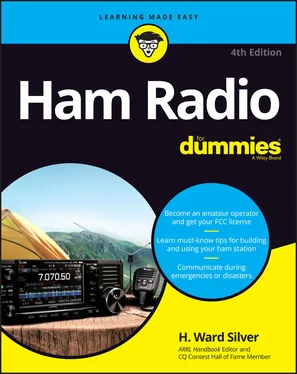This chapter gives you an overview of the world of ham radio and shows you how to become part of it.
HAM: NOT JUST FOR SANDWICHES ANYMORE
Everyone wants to know the meaning of the word ham, but as with many slang words, the origin is murky. Theories abound, ranging from the initials of an early radio club’s operators to the use of a meat tin as a natural sound amplifier. Of the many possibilities, the following theory seems to be the most believable.
“ Ham: a poor operator” was used in telegraphy even before radio. The first wireless operators were landline telegraphers who brought with them their language and the traditions of their much older profession. Government stations, ships, coastal stations, and the increasingly numerous amateur operators all competed for signal supremacy in one another’s receivers. Many of the amateur stations were very powerful and could effectively jam all the other operators in the area. When this logjam happened, frustrated commercial operators would send the message “THOSE HAMS ARE JAMMING YOU.” Amateurs, possibly unfamiliar with the real meaning of the term, picked it up and wore it with pride. As the years advanced, the original meaning completely disappeared.
Exploring Ham Radio around the World
Although the United States has a large population of hams, the amateur population in Europe is growing by leaps and bounds, and Japan has an even larger amateur population. With more than 3 million hams worldwide, very few countries are without an amateur (see the nearby sidebar “Where the hams are”). Ham radio is alive and well around the world. Listen to the ham radio frequency bands on a busy weekend and you’ll see what I mean!
Hams are required to have licenses, no matter where they operate. (I cover all things licensing in Part 2of this book.) The international agency that manages radio activity is the International Telecommunication Union (ITU; www.itu.int/en ). Each member country is required to have its own government agency in charge of licensing inside its borders. In the United States, hams are part of the Amateur Radio Service ( www.fcc.gov/wireless/bureau-divisions/mobility-division/amateur-radio-service ), which is regulated and licensed by the Federal Communications Commission (FCC). Outside the United States, amateur radio is governed by similar rules and regulations.
 Amateur radio licenses in America are granted by the FCC, but the licensing exams are administered by other hams acting as volunteer examiners (VEs). (I discuss VEs in detail in Chapter 4.) Classes and testing programs are often available through local clubs (see the section “ Clubs and online groups,” later in this chapter).
Amateur radio licenses in America are granted by the FCC, but the licensing exams are administered by other hams acting as volunteer examiners (VEs). (I discuss VEs in detail in Chapter 4.) Classes and testing programs are often available through local clubs (see the section “ Clubs and online groups,” later in this chapter).
The International Amateur Radio Union (IARU; www.iaru.org ) counts about 160 countries with a national radio society. Counting all the hams in all those countries is difficult, because in some countries, amateur stations and operators have separate licenses. The United States alone had more than 760,000 hams as of 2020 — the most ever. You may not be surprised to hear that China has the fastest-growing amateur population; Thailand and India aren’t far behind.
Because radio signals know no boundaries, hams have always been in touch across political borders. Even during the Cold War, U.S. and Soviet hams made regular contact, fostering long personal friendships and international goodwill. Although the Internet makes global communications easy, chatting over the airwaves with someone in another country or participating in a planet-wide competition is exciting and creates a unique personal connection.
 Since the adoption of international licensing regulations, hams have operated in many countries with minimal paperwork. For example, CEPT, the international treaty that enables countries to recognize one another’s amateur licenses, allows hams licensed in their home countries to operate within any other CEPT country. The ARRL provides a lot of useful material about international operating at
Since the adoption of international licensing regulations, hams have operated in many countries with minimal paperwork. For example, CEPT, the international treaty that enables countries to recognize one another’s amateur licenses, allows hams licensed in their home countries to operate within any other CEPT country. The ARRL provides a lot of useful material about international operating at www.arrl.org/international-regulatory .
Your interest in ham radio may be technical, you may want to use ham radio for public service or personal communications, or you may just want to join the fun. These are all perfectly valid reasons for getting a ham radio license.
You already use a radio to transmit all the time, although you probably don’t think of it that way. Your mobile phone is actually a very sophisticated, low-power portable radio! You don’t have to have a license to use it, of course; the phone company takes care of that. Nevertheless, your phone is really a radio, transmitting and receiving radio waves that are very similar to some of the radio waves that hams use. As you find out more about ham radio, you’ll also find out more about radio waves in general, and you’ll begin to look at your mobile phone in a whole new light.
Using electronics and technology
Ham radio lets you work closely with electronics and technology (see Chapter 2). Transmitting and receiving radio signals can be as much of an electronics-intensive endeavor as you like. By digging into the technology of ham radio, you’re gaining experience with everything from basic electronics to cutting-edge wireless techniques. Everything from analog electronics to the latest in digital signal processing and computing technology is applied in ham radio. Whatever part of electronic and computing technology you enjoy most, it’s all used in ham radio somewhere … and sometimes, all at the same time!
In this section, I give you a quick look at what you can do with technology.
 You don’t have to know everything that there is to know. I’ve been a ham for almost 50 years, and I’ve never met anyone who’s an expert on everything. A ham radio license is a license to learn!
You don’t have to know everything that there is to know. I’ve been a ham for almost 50 years, and I’ve never met anyone who’s an expert on everything. A ham radio license is a license to learn!
Just as an audiophile might, you can design and build your own equipment or assemble a station from factory-built components. All the components you need are widely available. Some of the original do-it-yourself (DIY) makers, hams delight in homebrewing, helping one another build and maintain stations. In software-defined radio (SDR) equipment, computer code is the new component, and I encourage you to experiment as much as you wish.
Experiment with radio waves
Besides being students of equipment and computers, hams are students of propagation, which is the means by which radio signals bounce around from place to place. Hams take an interest in solar cycles and sunspots and in the ways they affect the Earth’s ionosphere, that uppermost region of the atmosphere that reflects shortwave radio signals back to Earth. For hams, weather takes on new importance, too — microwave radio signals can travel long distances along storm fronts or reflect from rain or snow.
Antenna experimentation and computer modeling is a hotbed of activity in ham radio. New designs are created every day, and hams have contributed many advances and refinements to the antenna designer’s art. Antenna systems range from small patches of printed circuit-board material to multiple towers festooned with large rotating arrays. All you need to start growing your own antenna farm are some wire or tubing, a feed line, and some basic tools. I give you the full picture in Chapter 12.
Читать дальше

 Amateur radio licenses in America are granted by the FCC, but the licensing exams are administered by other hams acting as volunteer examiners (VEs). (I discuss VEs in detail in Chapter 4.) Classes and testing programs are often available through local clubs (see the section “ Clubs and online groups,” later in this chapter).
Amateur radio licenses in America are granted by the FCC, but the licensing exams are administered by other hams acting as volunteer examiners (VEs). (I discuss VEs in detail in Chapter 4.) Classes and testing programs are often available through local clubs (see the section “ Clubs and online groups,” later in this chapter). Since the adoption of international licensing regulations, hams have operated in many countries with minimal paperwork. For example, CEPT, the international treaty that enables countries to recognize one another’s amateur licenses, allows hams licensed in their home countries to operate within any other CEPT country. The ARRL provides a lot of useful material about international operating at
Since the adoption of international licensing regulations, hams have operated in many countries with minimal paperwork. For example, CEPT, the international treaty that enables countries to recognize one another’s amateur licenses, allows hams licensed in their home countries to operate within any other CEPT country. The ARRL provides a lot of useful material about international operating at 










